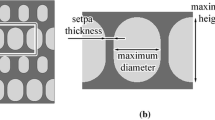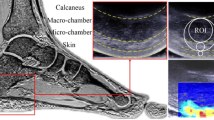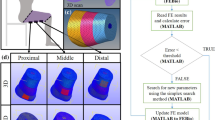Abstract
Recent research has shown that hyperelastic properties of the plantar soft tissue consisting of adipose tissue and fibrous septa change from region to region. However, relatively little research has been conducted to develop analytical or computational models to describe the region-specific behavior of the plantar soft tissue. The objective of the research is to develop a region-specific constitutive model of the plantar soft tissue. Plantar soft tissue specimens were dissected from six regions [subcalcaneal (CA), sublateral (LA), subnavicular (Nav), 1st, 3rd, and 5th submetatarsal (M1, M3, M5)] from cadaveric foot samples, and a picrosirius red staining technique was used to visualize the collagen fibers in fibrous septa. The volume fractions of adipose tissue and fibrous septa and the volume fractions of the principal orientations of the fibrous septa were calculated with the intensity gradient method. Region-specific constitutive models were then developed in finite element analysis considering the microstructure of the plantar soft tissue. The hyperelastic region specific material properties of the plantar soft tissue were validated with experimental unconfined compression tests and indentation tests from the literature. The results show that the models give reasonable predictions of the stiffness of the soft tissue within a standard deviation of the tests. The region-specific constitutive models help to explain how changes in the constituents are related to mechanical behavior of the soft tissue on a region specific basis.


















Similar content being viewed by others
References
Anderson K, Elsheikh A, Newson T (2003) Modelling the biomechanical effect of increasing intraocullar pressure on the porcine cornea. Paper presented at the 16th ASCE engineering mechanics conference. University of Washington, Seattle
Antunes P, Dias G, Coelho A, Rebelo F, Pereira T (2008) Non-linear finite element modelling of anatomically detailed 3D foot model Report paper, 1–11
Blechschmidt E (1982) The structure of the calcaneal padding. Foot Ankle 2:260–283
Buschmann WR, Jahss MH, Kummer F, Desai P, Gee RO, Ricci JL (1995) Histology and histomorphometric analysis of the normal and atrophic heel fat pad. Foot Ankle Int 16:254–258
Chen WP, Tang FT, Ju CW (2001) Stress distribution of the foot during mid-stance to push-off in barefoot gait: a 3-D finite element analysis. Clin Biomech 16:614–620. https://doi.org/10.1016/s0268-0033(01)00047-x
Cheung JT-M, Zhang M (2006) Finite element modeling of the human foot and footwear. Paper presented at the ABAQUS users’ conference
Cheung JT-M, Zhang M, An K-N (2006) Effect of Achilles tendon loading on plantar fascia tension in the standing foot. Clin Biomech 21:194–203
Cheung JTM, Zhang M, Leung AKL, Fan YB (2005) Three-dimensional finite element analysis of the foot during standing: a material sensitivity study. J Biomech 38:1045–1054. https://doi.org/10.1016/j.jbiomech.2004.05.035
Cichowitz A, Pan WR, Ashton M (2009) The heel anatomy, blood supply, and the pathophysiology of pressure ulcers. Ann Plast Surg 62:423–429. https://doi.org/10.1097/SAP.0b013e3181851655
Comley K, Fleck NA (2010) A micromechanical model for the Young’s modulus of adipose tissue. Int J Solids Struct 47:2982–2990. https://doi.org/10.1016/j.ijsolstr.2010.07.001
Erdemir A, Viveiros ML, Ulbrecht JS, Cavanagh PR (2006) An inverse finite-element model of heel-pad indentation. J Biomech 39:1279–1286. https://doi.org/10.1016/j.jbiomech.2005.03.007
Gefen A (2002) Stress analysis of the standing foot following surgical plantar fascia release. J Biomech 35:629–637. https://doi.org/10.1016/s0021-9290(01)00242-1
Grytz R, Meschke G (2009) Constitutive modeling of crimped collagen fibrils in soft tissues. J Mech Behav Biomed Mater 2:522–533. https://doi.org/10.1016/j.jmbbm.2008.12.009
Guler HC, Berme N, Simon SR (1998) A viscoelastic sphere model for the representation of plantar soft tissue during simulations. J Biomech 31:847–853
Hills AP, Hennig EM, McDonald M, Bar-Or O (2001) Plantar pressure differences between obese and non-obese adults: a biomechanical analysis. Int J Obes 25:1674–1679. https://doi.org/10.1038/sj.ijo.0801785
Hsu C-C, Tsai W-C, Wang C-L, Pao S-H, Shau Y-W, Chuan Y-S (2007) Microchambers and macrochambers in heel pads: are they functionally different? J Appl Physiol 102:2227–2231. https://doi.org/10.1152/japplphysiol.01137.2006
Hsu CC, Tsai WC, Chen CPC, Shau YW, Wang CL, Chen MJL, Chang KJ (2005) Effects of aging on the plantar soft tissue properties under the metatarsal heads at different impact velocities. Ultrasound Med Biol 31:1423–1429. https://doi.org/10.1016/j.ultrasmedbio.2005.05.009
Isvilanonda V, Dengler E, Iaquinto JM, Sangeorzan BJ, Ledoux WR (2012) Finite element analysis of the foot: model validation and comparison between two common treatments of the clawed hallux deformity. Clin Biomech 27:837–844. https://doi.org/10.1016/j.clinbiomech.2012.05.005
Jacob S, Patil MK (1999) Three-dimensional foot modeling and analysis of stresses in normal and early stage Hansen’s disease with muscle paralysis. J Rehabil Res Dev 36:252–263
Jahss MH et al (1992) Investigations into the fat pads of the sole of the foot: anatomy and histology. Foot Ankle 13:233–242
Johnson S, Kang L, Akil HM (2016) Mechanical behavior of jute hybrid bio-composites. Compos B Eng 91:83–93. https://doi.org/10.1016/j.compositesb.2015.12.052
Johnson S, Kang L, Zhan P (2016) Multi-scale constitutive region specific modelling of the plantar soft tissue. Paper presented at the Foot International 2016 Congress, Berlin, Germany, June 23–25
Junqueira LC, Bignolas G, Brentani RR (1979) Picrosirius staining plus polarization microscopy, a specific method for collagen detection in tissue sections. Histochem J 11:447–455. https://doi.org/10.1007/bf01002772
Karlon WJ, Covell JW, McCulloch AD, Hunter JJ, Omens JH (1998) Automated measurement of myofiber disarray in transgenic mice with ventricular expression of ras. Anat Rec 252:612–625. https://doi.org/10.1002/(sici)1097-0185(199812)252:4<612::aid-ar12>3.0.co;2-1
Klaesner JW, Hastings MK, Zou DQ, Lewis C, Mueller MJ (2002) Plantar tissue stiffness in patients with diabetes mellitus and peripheral neuropathy. Arch Phys Med Rehabil 83:1796–1801. https://doi.org/10.1053/apmr.2002.35661
Ledoux WR, Blevins JJ (2007) The compressive material properties of the plantar soft tissue. J Biomech 40:2975–2981. https://doi.org/10.1016/j.jbiomech.2007.02.009
Lemmon D, Shiang TY, Hashmi A, Ulbrecht JS, Cavanagh PR (1997) The effect of insoles in therapeutic footwear: a finite element approach. J Biomech 30:615–620. https://doi.org/10.1016/s0021-9290(97)00006-7
López Jiménez F (2016) On the isotropy of randomly generated representative volume elements for fiber-reinforced elastomers. Compos B Eng 87:33–39. https://doi.org/10.1016/j.compositesb.2015.10.014
Miller-Young JE, Duncan NA, Baroud G (2002) Material properties of the human calcaneal fat pad in compression: experiment and theory. J Biomech 35:1523–1531. https://doi.org/10.1016/s0021-9290(02)00090-8
Pai S, Ledoux WR (2010) The compressive mechanical properties of diabetic and non-diabetic plantar soft tissue. J Biomech 43:1754–1760. https://doi.org/10.1016/j.jbiomech.2010.02.021
Scott SH, Winter DA (1993) Biomechanical model of the human foot: kinematics and kinetics during the stance phase of walking. J Biomech 26:1091–1104. https://doi.org/10.1016/s0021-9290(05)80008-9
Spears IR, Miller-Young JE, Waters M, Rome K (2005) The effect of loading conditions on stress in the barefooted heel pad. Med Sci Sports Exerc 37:1030–1036. https://doi.org/10.1249/01.mss.0000171620.07016.6d
Tao K, Wang D, Wang C, Wang X, Liu A, Nester CJ, Howard D (2009) An in vivo experimental validation of a computational model of human foot. J Bionic Eng 6:387–397. https://doi.org/10.1016/s1672-6529(08)60138-9
Thomas VJ, Patil KM, Radhakrishnan S (2004) Three-dimensional, stress analysis for the mechanics of plantar ulcers in diabetic neuropathy. Med Biol Eng Comput 42:230–235. https://doi.org/10.1007/bf02344636
Tran P, Ngo TD, Ghazlan A, Hui D (2017) Bimaterial 3D printing and numerical analysis of bio-inspired composite structures under in-plane and transverse loadings. Compos B Eng 108:210–223. https://doi.org/10.1016/j.compositesb.2016.09.083
Wafai L, Zayegh A, Woulfe J, Aziz SM, Begg R (2015) Identification of foot pathologies based on plantar pressure. Asymmetry Sens 15:20392–20408. https://doi.org/10.3390/s150820392
Wang Y-N, Lee K, Ledoux WR (2011) Histomorphological evaluation of diabetic and non-diabetic plantar soft tissue. Foot Ankle Int 32:802–810. https://doi.org/10.3113/fai.2011.0802
Wang Y-N, Lee K, Shofer JB, Ledoux WR (2017) Histomorphological and biochemical properties of plantar soft tissue in diabetes. Foot 33:1–6. https://doi.org/10.1016/j.foot.2017.06.001
Yang LT (2008) Mechanical properties of collagen fibrils and elastic fibers explored by AFM. University of Twente
Zhan P, Ou H, Johnson S (2016) Development of a constitutive multi-scale region specific nested finite element model for the plantar soft tissue. Paper presented at the 12th World Congress on Computational Mechanics (WCCM XII), Seoul, South Korea, July 24–29
Acknowledgements
This study was funded by National Nature Science Foundation of China under Grant Nos. 51505282 and 51550110233.
Author information
Authors and Affiliations
Corresponding author
Ethics declarations
Conflict of interest
The authors have no conflicts to report.
Additional information
Publisher's Note
Springer Nature remains neutral with regard to jurisdictional claims in published maps and institutional affiliations.
Appendix
Appendix
1.1 Appendix (a)
Parametric analyses were conducted to study the influence of subimage size and collagen fibers threshold on results of the volume fractions of the principal orientations of fibrous septa. The process of image process is as following: (1) each image of the plantar soft tissue was divided into several square subimages for calculating the orientations of fibrous septa; (2) the subimages with the volume fraction of fibrous septa less than the threshold value were deleted; (3) the orientations of the fibrous septa were calculated with intensity gradient methods; (4) the volume fractions of the principal orientations of fibrous septa were calculated based on the distributions of orientations of fibrous septa.
Figures 16 and 17 show the influence of subimage size and the value of collagen fiber threshold on volume fraction results of principal orientations of fibrous septa. Subimages with a 40 pixel by 40 pixel size are used in this research. It is seen from Fig. 17 that the collagen fibers threshold has little influence on the results of volume fractions of the principal orientations of fibrous septa. The value of 15% is set as the threshold of the collagen fibers.
1.2 Appendix (b)
Error analysis of the image algorithm was conducted as the study by Karlon et al. (1998). Phantom images were generated, consisting of short line segments evenly distributed. Orientation of the short line segments follows a von Mises distribution with known mean and standard deviation (SD). The orientation of short lien segments was characterized by the image algorithm and the obtained mean and SD of orientation was compared to the specified values.
Two series of images were generated. In the 1st series, the SD of the orientation was kept constant (\(15{^{\circ }}\)). Mean orientation was varied from \(-80{^{\circ }}\) to \(80{^{\circ }}\). In the 2nd, the mean orientation was kept constant (\(0{^{\circ }}\)) and SD was varied from \(5{^{\circ }}\) to \(40{^{\circ }}\). Results are shown in Fig. 18. The obtained mean orientation is closely matching the actual mean orientation, while the obtained SD is within \(3{^{\circ }}\) of the actual.
1.3 Appendix (c)
Young’s modulus of adipose tissue was ranging from 1 kPa to 3 MPa (Comley and Fleck 2010). A parametric study was conducted to determine Young’s modulus of adipose tissue of the human plantar soft tissue.
Six different values of Young’s modulus of adipose tissue in the range given by Comley et al. (2010) were assigned to the plantar soft tissue model in subcalcaneal region, while the rest of the parameters were kept constant. Stress versus strain relationships of plantar soft tissue model with these six different Young’s modulus of adipose tissue were compared with Lemmon’s (1997) experimental data as shown in Fig. 19, and the R-Squared values between finite element models and experimental results are calculated and summarized in Table 5. It is seen that the plantar soft tissue model with the Young’s modulus of adipose tissue of 0.03 MPa provides a reasonable prediction with R-squared value equal to 0.91.
Rights and permissions
About this article
Cite this article
Ou, H., Zhan, P., Kang, L. et al. Region-specific constitutive modeling of the plantar soft tissue. Biomech Model Mechanobiol 17, 1373–1388 (2018). https://doi.org/10.1007/s10237-018-1032-9
Received:
Accepted:
Published:
Issue Date:
DOI: https://doi.org/10.1007/s10237-018-1032-9





